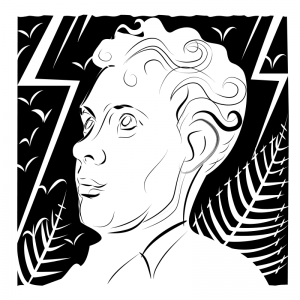Who is Dylan Thomas to you?

Is he a rebel? A ‘one-off’ that sticks two fingers up to authority and does things his own way.

Is he the doomed poet? The wild-eyed and troubled bard knocking back shot after shot of whisky and intent on self-destruction?

It’s possible that you may recall him as a deep and rhythmic voice booming from the radio.


Or, when you think about Dylan Thomas, do you think about Wales?
Well, what if Dylan Thomas were all of those things and more? What if he could be commercialised, and creatively exploited to sell a product? And what if that product was a country?
Wales saw the potential of utilising the Dylan Thomas connection in 2014, but other Celtic nations have done similar things with their literary figures too, for example Ireland with James Joyce, and Scotland with Robert Burns. Last week I listened to a very interesting radio documentary that discussed the financial benefits of Burns the Brand.

Scotland has truly embraced the idea of Robert Burns as a cultural icon. His face is proudly presented on their £5 note and they have adopted his achievements as their own, celebrating accordingly. They have turned him into a Scottish superstar. And has it worked? When you think of Burns, do you automatically think of Scotland?
But how much is that pride worth to the Scottish economy? Well, consider the following things: the Burns’ tourist sites, merchandise, Burns’ Suppers’ revenue (extra sales of haggis, oatcakes, and whisky!), as well as the other income Burns’ tourists bring in, for example eating out or booking taxis. The final figure is quite staggering. In 2009, the 250th anniversary of Robert Burn’s birth, it was estimated to be about £159 million.

Now, returning to Wales. Dylan Thomas 100 was a year-long festival that exploded with theatre shows, literary tours, book launches, TV dramas, films, a coin and stamp, as well as a royal and state visit. Many summed it up as a truly extraordinary expression of Dylan’s works through the arts. (See some of examples of the year’s events at the end of this blog.)
But there were critics of the celebrations too. Some did not like that Dylan Thomas was being used as a marketing tool and felt that the events were guilty of dumbing Dylan down. They thought that the emphasis on the creative arts took the focus away from Dylan’s actual writings and the opportunity to increase understanding of his work, and therefore, leave a lasting impression.
While I recognise that it was theatre, music and art heavy, having been funded mainly by the Welsh Art’s Council, I would strongly challenge that the year did not leave a lasting impression. It certainly did for me! And for many others as well, young and old and from across the world. They either discovered or rediscovered Dylan’s writing as a direct result of the centenary year and the higher status given to Dylan Thomas. There was also a large social media following generated, who are still very active, as well as the creation of an annual Dylan Day on May 14th.
I suspect you may think I would be uncomfortable with the idea of my grandfather being used as a brand to promote a country. They often did during the DT 100 steering group meetings, avoiding using the word ‘brand’ at all costs, or apologising profusely if they accidentally did. But in actual fact I can see it as very advantageous for all involved, as long as it is done in a fitting and respectful way. Now, that’s a whole different subject matter, which I touched upon in last week’s blog. In my opinion, it all comes together perfectly: the places, his life and his work. Experiencing and learning about all of these collectively must surely give a deeper understanding of his words and the real man behind them.
Were certain opportunities missed during Dylan Thomas 100? Well, with hindsight, there’s always more that could have been done, but I believe, as a whole, it was a big success. Though perhaps there was one mistake which was viewing the year as one major event rather than the start of a journey that would result in a lasting legacy for Dylan Thomas and Wales. The centenary worked particularly well to bring Welsh literature, tourism, cultural, arts and media organisations together for the first time as they had a shared vision. I very cautiously say this, but I do have a deep concern that the fragmented approach to Dylan Thomas, that was very evident prior to the centenary, will return because there is not a structure in place to help everyone work as one. I had hoped that there would be an all-Wales interactive Dylan Thomas ‘trail’ created as a legacy of the year. Unfortunately, and I suspect because more money being spent on Dylan Thomas could not be justified, that did not materialise. However, I’m not deterred, as I know I can’t work miracles, but one way I will try to link it all up is via the new website, and through social media, under our Discover Dylan Thomas umbrella.


Photo 1 and Dylan logo – based on Nora Summers photos © Gabriel Summers
Photo 2 – © Bunny Adler
Hannah Ellis – 6th February 2017.
Hannah is a teacher, writer and consultant. You can learn more about her by visiting the website – http://www.hannahellisconsultancy.com
A few examples of some of the Dylan Thomas 100 events
Peter Blake and Under Milk Wood.
Polly Garter’s Aria from Under Milk Wood Opera.
Theatre Iolo’s Adventures in the Skintrade
A reading of Fern Hill by Twitter users.
A reading of Do Not Go Gentle by Welsh actors.
The Wales Theatre Company – A Child’s Christmas in Wales.


Leave A Comment